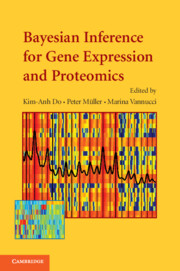Book contents
- Frontmatter
- Contents
- List of Contributors
- Preface
- 1 An Introduction to High-Throughput Bioinformatics Data
- 2 Hierarchical Mixture Models for Expression Profiles
- 3 Bayesian Hierarchical Models for Inference in Microarray Data
- 4 Bayesian Process-Based Modeling of Two-Channel Microarray Experiments: Estimating Absolute mRNA Concentrations
- 5 Identification of Biomarkers in Classification and Clustering of High-Throughput Data
- 6 Modeling Nonlinear Gene Interactions Using Bayesian MARS
- 7 Models for Probability of Under- and Overexpression: The POE Scale
- 8 Sparse Statistical Modelling in Gene Expression Genomics
- 9 Bayesian Analysis of Cell Cycle Gene Expression Data
- 10 Model-Based Clustering for Expression Data via a Dirichlet Process Mixture Model
- 11 Interval Mapping for Expression Quantitative Trait Loci
- 12 Bayesian Mixture Models for Gene Expression and Protein Profiles
- 13 Shrinkage Estimation for SAGE Data Using a Mixture Dirichlet Prior
- 14 Analysis of Mass Spectrometry Data Using Bayesian Wavelet-Based Functional Mixed Models
- 15 Nonparametric Models for Proteomic Peak Identification and Quantification
- 16 Bayesian Modeling and Inference for Sequence Motif Discovery
- 17 Identification of DNA Regulatory Motifs and Regulators by Integrating Gene Expression and Sequence Data
- 18 A Misclassification Model for Inferring Transcriptional Regulatory Networks
- 19 Estimating Cellular Signaling from Transcription Data
- 20 Computational Methods for Learning Bayesian Networks from High-Throughput Biological Data
- 21 Bayesian Networks and Informative Priors: Transcriptional Regulatory Network Models
- 22 Sample Size Choice for Microarray Experiments
- Plate section
10 - Model-Based Clustering for Expression Data via a Dirichlet Process Mixture Model
Published online by Cambridge University Press: 23 November 2009
- Frontmatter
- Contents
- List of Contributors
- Preface
- 1 An Introduction to High-Throughput Bioinformatics Data
- 2 Hierarchical Mixture Models for Expression Profiles
- 3 Bayesian Hierarchical Models for Inference in Microarray Data
- 4 Bayesian Process-Based Modeling of Two-Channel Microarray Experiments: Estimating Absolute mRNA Concentrations
- 5 Identification of Biomarkers in Classification and Clustering of High-Throughput Data
- 6 Modeling Nonlinear Gene Interactions Using Bayesian MARS
- 7 Models for Probability of Under- and Overexpression: The POE Scale
- 8 Sparse Statistical Modelling in Gene Expression Genomics
- 9 Bayesian Analysis of Cell Cycle Gene Expression Data
- 10 Model-Based Clustering for Expression Data via a Dirichlet Process Mixture Model
- 11 Interval Mapping for Expression Quantitative Trait Loci
- 12 Bayesian Mixture Models for Gene Expression and Protein Profiles
- 13 Shrinkage Estimation for SAGE Data Using a Mixture Dirichlet Prior
- 14 Analysis of Mass Spectrometry Data Using Bayesian Wavelet-Based Functional Mixed Models
- 15 Nonparametric Models for Proteomic Peak Identification and Quantification
- 16 Bayesian Modeling and Inference for Sequence Motif Discovery
- 17 Identification of DNA Regulatory Motifs and Regulators by Integrating Gene Expression and Sequence Data
- 18 A Misclassification Model for Inferring Transcriptional Regulatory Networks
- 19 Estimating Cellular Signaling from Transcription Data
- 20 Computational Methods for Learning Bayesian Networks from High-Throughput Biological Data
- 21 Bayesian Networks and Informative Priors: Transcriptional Regulatory Network Models
- 22 Sample Size Choice for Microarray Experiments
- Plate section
Summary
Abstract
This chapter describes a clustering procedure for microarray expression data based on a well-defined statistical model, specifically, a conjugate Dirichlet process mixture model. The clustering algorithm groups genes whose latent variables governing expression are equal, that is, genes belonging to the same mixture component. The model is fit with Markov chain Monte Carlo and the computational burden is eased by exploiting conjugacy. This chapter introduces a method to get a point estimate of the true clustering based on least-squares distances from the posterior probability that two genes are clustered. Unlike ad hoc clustering methods, the model provides measures of uncertainty about the clustering. Further, the model automatically estimates the number of clusters and quantifies uncertainty about this important parameter. The method is compared to other clustering methods in a simulation study. Finally, the method is demonstrated with actual microarray data.
Introduction
The main goal of clustering microarray data is to group genes that present highly correlated data; this correlation may reflect underlying biological factors of interest, such as regulation by a common transcription factor. A variety of heuristic clustering methods exist, including k-means clustering (MacQueen 1967) and hierarchical agglomerative clustering. These methods have had an enormous impact in genomics (Eisen et al. 1998) and are intuitively appealing. Nevertheless, the statistical properties of these heuristic clustering methods are generally not known. Model-based clustering procedures have been proposed for microarray data, including (1) the MCLUST procedure of Fraley and Raftery (2002) and Yeung et al. (2001), and (2) the Bayesian mixture model based clustering of Medvedovic and Sivaganesan (2002) and Medvedovic et al. (2004).
- Type
- Chapter
- Information
- Bayesian Inference for Gene Expression and Proteomics , pp. 201 - 218Publisher: Cambridge University PressPrint publication year: 2006
- 140
- Cited by



